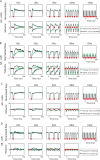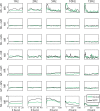Low-pass filter properties of basal ganglia cortical muscle loops in the normal and MPTP primate model of parkinsonism
- PMID: 18199764
- PMCID: PMC6670346
- DOI: 10.1523/JNEUROSCI.3388-07.2008
Low-pass filter properties of basal ganglia cortical muscle loops in the normal and MPTP primate model of parkinsonism
Abstract
Oscillatory bursting activity is commonly found in the basal ganglia (BG) and the thalamus of the parkinsonian brain. The frequency of these oscillations is often similar to or higher than that of the parkinsonian tremor, but their relationship to the tremor and other parkinsonian symptoms is still under debate. We studied the frequency dependency of information transmission in the cortex-BG and cortex-periphery loops by recording simultaneously from multiple electrodes located in the arm-related primary motor cortex (MI) and in the globus pallidus (GP) of two vervet monkeys before and after 1-methyl-4-phenyl-1,2,3,6-tetrahydropyridine (MPTP) treatment and induction of parkinsonian symptoms. We mimicked the parkinsonian bursting oscillations by stimulating with 35 ms bursts given at different frequencies through microelectrodes located in MI or GP while recording the evoked neuronal and motor responses. In the normal state, microstimulation of MI or GP does not modulate the discharge rate in the other structure. However, the functional-connectivity between MI and GP is greatly enhanced after MPTP treatment. In the frequency domain, GP neurons usually responded equally to 1-15 Hz stimulation bursts in both states. In contrast, MI neurons demonstrated low-pass filter properties, with a cutoff frequency above 5 Hz for the MI stimulations, and below 5 Hz for the GP stimulations. Finally, muscle activation evoked by MI microstimulation was markedly attenuated at frequencies higher than 5 Hz. The low-pass properties of the pathways connecting GP to MI to muscles suggest that parkinsonian tremor is not directly driven by the BG 5-10 Hz burst oscillations despite their similar frequencies.
Figures








Similar articles
-
Computational physiology of the basal ganglia in Parkinson's disease.Prog Brain Res. 2010;183:259-73. doi: 10.1016/S0079-6123(10)83013-4. Prog Brain Res. 2010. PMID: 20696324
-
Enhanced synchrony among primary motor cortex neurons in the 1-methyl-4-phenyl-1,2,3,6-tetrahydropyridine primate model of Parkinson's disease.J Neurosci. 2002 Jun 1;22(11):4639-53. doi: 10.1523/JNEUROSCI.22-11-04639.2002. J Neurosci. 2002. PMID: 12040070 Free PMC article.
-
Firing patterns and correlations of spontaneous discharge of pallidal neurons in the normal and the tremulous 1-methyl-4-phenyl-1,2,3,6-tetrahydropyridine vervet model of parkinsonism.J Neurosci. 2000 Nov 15;20(22):8559-71. doi: 10.1523/JNEUROSCI.20-22-08559.2000. J Neurosci. 2000. PMID: 11069964 Free PMC article.
-
Experimental parkinsonism in primates.Stereotact Funct Neurosurg. 2001;77(1-4):91-7. doi: 10.1159/000064603. Stereotact Funct Neurosurg. 2001. PMID: 12378063 Review.
-
What basal ganglia changes underlie the parkinsonian state? The significance of neuronal oscillatory activity.Neurobiol Dis. 2013 Oct;58:242-8. doi: 10.1016/j.nbd.2013.05.010. Epub 2013 May 30. Neurobiol Dis. 2013. PMID: 23727447 Free PMC article. Review.
Cited by
-
Correlation transfer from basal ganglia to thalamus in Parkinson's disease.Front Comput Neurosci. 2011 Dec 13;5:58. doi: 10.3389/fncom.2011.00058. eCollection 2011. Front Comput Neurosci. 2011. PMID: 22355287 Free PMC article.
-
Cerebral causes and consequences of parkinsonian resting tremor: a tale of two circuits?Brain. 2012 Nov;135(Pt 11):3206-26. doi: 10.1093/brain/aws023. Epub 2012 Mar 1. Brain. 2012. PMID: 22382359 Free PMC article. Review.
-
Non-stationary discharge patterns in motor cortex under subthalamic nucleus deep brain stimulation.Front Integr Neurosci. 2012 Jun 25;6:35. doi: 10.3389/fnint.2012.00035. eCollection 2012. Front Integr Neurosci. 2012. PMID: 22754509 Free PMC article.
-
A Systematic Review of Neurofeedback for the Management of Motor Symptoms in Parkinson's Disease.Brain Sci. 2021 Sep 29;11(10):1292. doi: 10.3390/brainsci11101292. Brain Sci. 2021. PMID: 34679358 Free PMC article. Review.
-
Increased thalamic centrality and putamen-thalamic connectivity in patients with parkinsonian resting tremor.Brain Behav. 2016 Nov 23;7(1):e00601. doi: 10.1002/brb3.601. eCollection 2017 Jan. Brain Behav. 2016. PMID: 28127519 Free PMC article.
References
-
- Alberts WW. A simple view of parkinsonian tremor, electrical stimulation of cortex adjacent to the rolandic fissure in awake man. Brain Res. 1972;44:357–369. - PubMed
-
- Albin RL, Young AB, Penney JB. The functional anatomy of basal ganglia disorders. Trends Neurosci. 1989;12:366–375. - PubMed
-
- Alexander GE, DeLong MR. Microstimulation of the primate neostriatum. I. Physiological properties of striatal microexcitable zones. J Neurophysiol. 1985;53:1401–1416. - PubMed
-
- Alexander GE, DeLong MR, Strick PL. Parallel organization of functionally segregated circuits linking basal ganglia and cortex. Annu Rev Neurosci. 1986;9:357–381. - PubMed
-
- Asanuma H, Rosen I. Topographical organization of cortical efferent zones projecting to distal forelimb muscles in the monkey. Exp Brain Res. 1972;14:243–256. - PubMed
Publication types
MeSH terms
Substances
LinkOut - more resources
Full Text Sources
